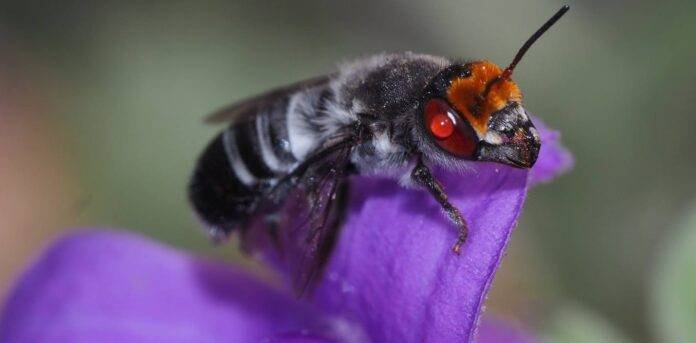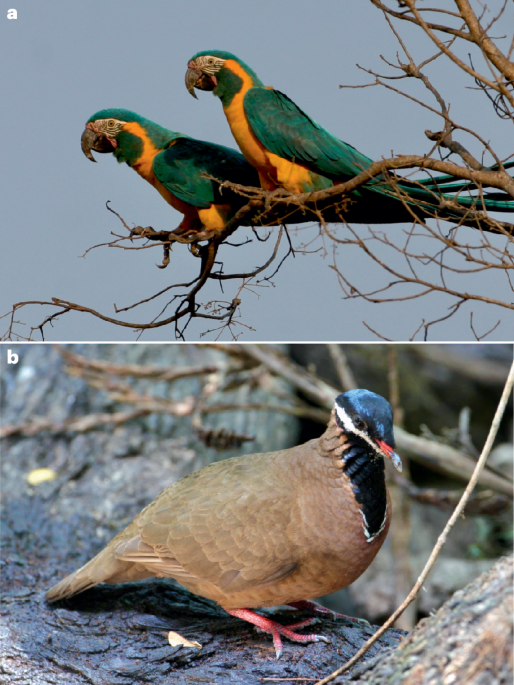Willig, M. R. Biodiversity and productivity. Science 333, 1709–1710 (2011).
Mittelbach, G. G. et al. What is the observed relationship between species richness and productivity? Ecology 82, 2381–2396 (2001).
Grace, J. B. et al. Integrative modelling reveals mechanisms linking productivity and plant species richness. Nature 529, 390–393 (2016).
Lavers, C. & Field, R. A resource‐based conceptual model of plant diversity that reassesses causality in the productivity–diversity relationship. Glob. Ecol. Biogeogr. 15, 213–224 (2006).
Reich, P. B. et al. Impacts of biodiversity loss escalate through time as redundancy fades. Science 336, 589–592 (2012).
Tilman, D., Reich, P. B. & Isbell, F. Biodiversity impacts ecosystem productivity as much as resources, disturbance, or herbivory. Proc. Natl Acad. Sci. USA 109, 10394–10397 (2012).
Huang, Y. et al. Impacts of species richness on productivity in a large-scale subtropical forest experiment. Science 362, 80–83 (2018).
Bongers, F. J. et al. Functional diversity effects on productivity increase with age in a forest biodiversity experiment. Nat. Ecol. Evol. 5, 1594–1603 (2021).
Li, C. et al. The productive performance of intercropping. Proc. Natl Acad. Sci. USA 120, e2201886120 (2023).
Grace, J. B. et al. Does species diversity limit productivity in natural grassland communities? Ecol. Lett. 10, 680–689 (2007).
Adler, P. B. et al. Productivity is a poor predictor of plant species richness. Science 333, 1750–1753 (2011).
Fraser, L. H. et al. Worldwide evidence of a unimodal relationship between productivity and plant species richness. Science 349, 302–305 (2015).
Tredennick, A. T. et al. Comment on “Worldwide evidence of a unimodal relationship between productivity and plant species richness”. Science 351, 457 (2016).
Liang, J. et al. Positive biodiversity–productivity relationship predominant in global forests. Science 354, aaf8957 (2016).
Duffy, J. E., Godwin, C. M. & Cardinale, B. J. Biodiversity effects in the wild are common and as strong as key drivers of productivity. Nature 549, 261–264 (2017).
Dee, L. E. et al. Clarifying the effect of biodiversity on productivity in natural ecosystems with longitudinal data and methods for causal inference. Nat. Commun. 14, 2607 (2023).
Hubbell, S. P. The Unified Neutral Theory of Biodiversity and Biogeography (Princeton Univ. Press, 2001).
Magurran, A. E. & Henderson, P. A. Explaining the excess of rare species in natural species abundance distributions. Nature 422, 714–716 (2003).
McGill, B. J. et al. Species abundance distributions: moving beyond single prediction theories to integration within an ecological framework. Ecol. Lett. 10, 995–1015 (2007).
Fisher, R. A., Corbet, A. S. & Williams, C. B. The relation between the number of species and the number of individuals in a random sample of an animal population. J. Anim. Ecol. 12, 42–58 (1943).
MacArthur, R. H. On the relative abundance of bird species. Proc. Natl Acad. Sci. USA 43, 293–295 (1957).
Whittaker, R. H. Dominance and diversity in land plant communities: numerical relations of species express the importance of competition in community function and evolution. Science 147, 250–260 (1965).
Smith, M. D. & Knapp, A. K. Dominant species maintain ecosystem function with non-random species loss. Ecol. Lett. 6, 509–517 (2003).
Roswell, M., Dushoff, J. & Winfree, R. A conceptual guide to measuring species diversity. Oikos 130, 321–338 (2021).
Cooper, D. L. M. et al. Consistent patterns of common species across tropical tree communities. Nature 625, 728–734 (2024).
Grime, J. P. Benefits of plant diversity to ecosystems: immediate, filter and founder effects. J. Ecol. 86, 902–910 (1998).
Dangles, O. & Malmqvist, B. Species richness–decomposition relationships depend on species dominance. Ecol. Lett. 7, 395–402 (2004).
Winfree, R., Fox, J. W., Williams, N. M., Reilly, J. R. & Cariveau, D. P. Abundance of common species, not species richness, drives delivery of a real-world ecosystem service. Ecol. Lett. 18, 626–635 (2015).
Avolio, M. L. et al. Demystifying dominant species. New Phytol. 223, 1106–1126 (2019).
Preston, F. W. The commonness, and rarity, of species. Ecology 29, 254–283 (1948).
Limpert, E., Stahel, W. A. & Abbt, M. Log-normal distributions across the sciences: keys and clues. BioScience 51, 341–352 (2001).
Ulrich, W., Ollik, M. & Ugland, K. I. A meta-analysis of species–abundance distributions. Oikos 119, 1149–1155 (2010).
Callaghan, C. T., Borda-de-Água, L., Van Klink, R., Rozzi, R. & Pereira, H. M. Unveiling global species abundance distributions. Nat. Ecol. Evol. 7, 1600–1609 (2023).
Callaghan, C. T., Santini, L., Spake, R. & Bowler, D. E. Population abundance estimates in conservation and biodiversity research. Trends Ecol. Evol. 39, 515–523 (2024).
McNaughton, S. J. & Volf, L. L. Dominance and the niche in ecological systems: dominance is an expression of ecological inequalities arising out of different exploitation strategies. Science 167, 131–139 (1970).
Leibold, M. A., Chase, J. M. & Ernest, S. K. M. Community assembly and the functioning of ecosystems: how metacommunity processes alter ecosystems attributes. Ecology 98, 909–919 (2017).
Bannar‐Martin, K. H. et al. Integrating community assembly and biodiversity to better understand ecosystem function: the Community Assembly and the Functioning of Ecosystems (CAFE) approach. Ecol. Lett. 21, 167–180 (2018).
Harte, J., Brush, M., Newman, E. A. & Umemura, K. An equation of state unifies diversity, productivity, abundance and biomass. Commun. Biol. 5, 874 (2022).
Ladouceur, E. et al. Linking changes in species composition and biomass in a globally distributed grassland experiment. Ecol. Lett. 25, 2699–2712 (2022).
Nair, J., Wierman, A. & Zwart, B. The Fundamentals of Heavy Tails: Properties, Emergence, and Estimation Vol. 53 (Cambridge Univ. Press, 2022).
Bock, C. E., Jones, Z. F. & Bock, J. H. Relationships between species richness, evenness, and abundance in a southwestern savanna. Ecology 88, 1322–1327 (2007).
Locey, K. J. & White, E. P. How species richness and total abundance constrain the distribution of abundance. Ecol. Lett. 16, 1177–1185 (2013).
Zhang, P. et al. SRUD: a simple non-destructive method for accurate quantification of plant diversity dynamics. J. Ecol. 107, 2155–2166 (2019).
Zhang, P. et al. Space resource utilization of dominant species integrates abundance‐ and functional‐based processes for better predictions of plant diversity dynamics. Oikos 4, e09519 (2023).
Borer, E. T. et al. Finding generality in ecology: a model for globally distributed experiments. Methods Ecol. Evol. 5, 65–73 (2014).
Wilfahrt, P. A. et al. Nothing lasts forever: dominant species decline under rapid environmental change in global grasslands. J. Ecol. 111, 2472–2482 (2023).
Pan, X. et al. The convex relationship between plant cover and biomass: implications for assessing species and community properties. J. Veg. Sci. 35, e13288 (2024).
De Haan, L. Sample extremes: an elementary introduction. Stat. Neerl. 30, 161–172 (1976).
Goldberg, D. E. & Barton, A. M. Patterns and consequences of interspecific competition in natural communities: a review of field experiments with plants. Am. Nat. 139, 771–801 (1992).
Mac Nally, R. Use of the abundance spectrum and relative–abundance distributions to analyze assemblage change in massively altered landscapes. Am. Nat. 170, 319–330 (2007).
Chao, A., Chiu, C. H. & Jost, L. Unifying species diversity, phylogenetic diversity, functional diversity, and related similarity and differentiation measures through hill numbers. Annu. Rev. Ecol. Evol. Syst. 45, 297–324 (2014).
Kissling, W. D. et al. Building essential biodiversity variables (EBVs) of species distribution and abundance at a global scale. Biol. Rev. 93, 600–625 (2018).
Pearse, I. S., Sofaer, H. R., Zaya, D. N. & Spyreas, G. Non‐native plants have greater impacts because of differing per‐capita effects and nonlinear abundance–impact curves. Ecol. Lett. 22, 1214–1220 (2019).
Gotelli, N. J. et al. Estimating species relative abundances from museum records. Methods Ecol. Evol. 14, 431–443 (2023).
Dawson, G. The usefulness of absolute (“census”) and relative (“sampling” or “index”) measures of abundance. Stud. Avian Biol. 6, 554–558 (1981).
Theodose, T. A. & Bowman, W. D. Nutrient availability, plant abundance, and species diversity in two alpine tundra communities. Ecology 78, 1861–1872 (1997).
Royle, J. A. & Nichols, J. D. Estimating abundance from repeated presence–absence data or point counts. Ecology 84, 777–790 (2003).
Chao, A., Hsieh, T. C., Chazdon, R. L., Colwell, R. K. & Gotelli, N. J. Unveiling the species‐rank abundance distribution by generalizing the Good–Turing sample coverage theory. Ecology 96, 1189–1201 (2015).
Burton, A. C. et al. Wildlife camera trapping: a review and recommendations for linking surveys to ecological processes. J. Appl. Ecol. 52, 675–685 (2015).
Cerini, F., Childs, D. Z. & Clements, C. F. A predictive timeline of wildlife population collapse. Nat. Ecol. Evol. 7, 320–331 (2023).
Tilman, D. The ecological consequences of changes in biodiversity: a search for general principles. Ecology 80, 1455–1474 (1999).
Allan, E. et al. More diverse plant communities have higher functioning over time due to turnover in complementary dominant species. Proc. Natl Acad. Sci. USA 108, 17034–17039 (2011).
Mallmin, E., Traulsen, A. & De Monte, S. Chaotic turnover of rare and abundant species in a strongly interacting model community. Proc. Natl Acad. Sci. USA 121, e2312822121 (2024).
Gilbert, B., Turkington, R. & Srivastava, D. S. Dominant species and diversity: linking relative abundance to controls of species establishment. Am. Nat. 174, 850–862 (2009).
Fay, P. A. et al. Grassland productivity limited by multiple nutrients. Nat. Plants 1, 15080 (2015).
Karatzas, I. & Shreve, S. E. Brownian Motion and Stochastic Calculus (Springer Science & Business Media, 1998).
Kindt, R. & Coe, R. Tree Diversity Analysis: A Manual and Software for Common Statistical Methods for Ecological and Biodiversity Studies (World Agroforestry Centre, 2005).
Pinheiro, J. & Bates, D. Mixed-Effects Models in S and S-PLUS (Springer Science & Business Media, 2006).
Lefcheck, J. S. piecewiseSEM: piecewise structural equation modelling in R for ecology, evolution, and systematics. Methods Ecol. Evol. 7, 573–579 (2016).
R Development Core Team. R: A Language and Environment for Statistical Computing (R Foundation for Statistical Computing, 2023).
Borer, E. T. et al. Species cover, community biomass, and richness in global grasslands from NutNet (2007–2023): dominant species predict plant richness and biomass in global grasslands ver 4. Environmental Data Initiative https://doi.org/10.6073/pasta/442895326274ea09942bd04e6ea92df2 (2025).






